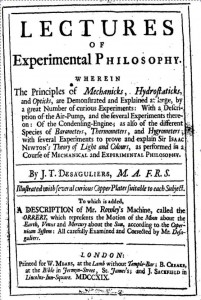Peter Anstey writes…
 According to ECCO there were one hundred books published in the eighteenth century with the term ‘experimental philosophy’ in their title. What is surprising about these books is that the majority of them are courses in or lectures on experimental philosophy: they are pedagogical works rather than works in natural philosophy per se.
According to ECCO there were one hundred books published in the eighteenth century with the term ‘experimental philosophy’ in their title. What is surprising about these books is that the majority of them are courses in or lectures on experimental philosophy: they are pedagogical works rather than works in natural philosophy per se.
One of the earliest of these works was Lectures of Experimental Philosophy by John Theophilus Desaguliers published in 1719. This work gives the principles of mechanics, hydrostatics and optics, explaining them with descriptions of experiments that had recently been used in these disciplines.
The work is written in the spirit of the experimental philosophy and before Desaguliers launches into his exposition of mechanics, the first discipline that he discusses, he provides the reader with a sketch of the ‘principles’ of natural philosophy. What is interesting is that much of this derives without acknowledgment from Robert Boyle’s Origin of Forms and Qualities (1666/7). Thus, Desaguliers tells us that:
- 1. That the Matter of Natural Bodies is the same; namely, a Substance extended, divisible, and impenetrable. (p. 7)
In Forms and Qualities Boyle says,
- The Matter of all Natural Bodies is the Same, namely a Substance extended and impenetrable. (Works of Robert Boyle, eds Hunter & Davis, 5: 333)
If one were to quibble that Desaguliers has left out the word ‘divisible’, we need only to turn to an earlier passage in Forms and Qualities where Boyle says:
- there is one catholic or universal matter common to all bodies, by which I mean a substance extended, divisible, and impenetrable. (Works, 5: 305)
That Desaguliers read this passage is evident from his third claim:
- 3. That Local Motion is the chief Principle amongst second Causes, and the chief Agent of all that happens in Nature. (p. 8)
Boyle says in the very next paragraph,
- that Local Motion seems to be indeed the Principl amongst Second Causes, and the Grand Agent of all that happens in Nature. (Works, 5: 306)
There are other borrowings from Forms and Qualities, but space prevents me from listing them here. Two points are worth noting, however. First, it is very interesting to see concrete evidence of the influence of Boyle’s Forms and Qualities in the latter years of the second decade of the eighteenth century. Until now there has been little recognition of the impact of this specific work by Boyle, though few would doubt his enormous impact on British experimental philosophy in general.
Second, the text that Desaguliers lifts from Boyle appears in the speculative part of Forms and Qualities: it is speculative natural philosophy and is supported in the ‘historical part’ of that work by experimental observations. There is no sense of this division in Desaguliers’ treatment of these ‘principles’, though he does bring some experimental evidence to bear against the Cartesian materia subtilis. After dismissing various other speculative theories, such as Aristotelianism, Desaguliers simply introduces Boyle’s speculative theory with the following words:
- That Philosophy therefore is the most reasonable, which teaches …

